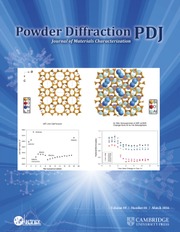Article contents
Effect of layer structure boundary on the hectorite basal diffraction
Published online by Cambridge University Press: 01 March 2012
Abstract
This study examined basal peak irrationalities according to boundary conditions of the hectorite basal diffraction unit (BDU), which were recognized as the total assembly of 2:1 phyllosilicate layer plus interlayer material. The hectorite basal profiles were computer-simulated using the three kinds of BDU settings identified from the middle of octahedral sheets in the nearest neighbor (centrosymmetric model), the middle of interlayers in the nearest neighbor (centrosymmetric model), and a basal oxygen plane to the margin of interlayer in contact with the next phyllosilicate layer (non-centrosymmetric model). In the results of simulations, irrationality and asymmetry of the hectorite basal peaks relied straightforwardly on the BDU scattering modulations for the non-Bragg angles containing information on the synergic scattering events of phyllosilicate layer and interlayer material. Among the concerned BDU boundaries, the non-centrosymmetric model more effectively represented the real hectorite profile than the two previously reported centrosymmetric models.
Information
- Type
- Technical Articles
- Information
- Copyright
- Copyright © Cambridge University Press 2006
References
- 1
- Cited by

